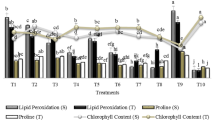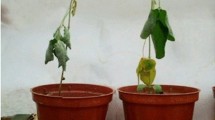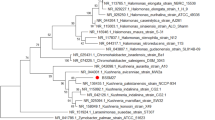Abstract
Plant growth promoting rhizobacteria were isolated and characterized from sandy soils in Pakistan. The role of the rhizobacteria, in association with plant growth regulators, was studied on the roots of wheat grown under water stressed conditions. The plant growth promoting rhizobacteria were characterized on the basis of colony morphology, biochemical traits and identified on the basis of 16S-rRNA gene sequencing which identified the selected isolates Planomicrobium chinense, Bacillus cereus and Pseudomonas fluorescens. Antibacterial and antifungal activities were determined. The fresh cultures (24 h old) of isolates were used to soak the seeds for 2–3 h prior to sowing. The growth regulators salicylic acid and putrescine were applied to the plant as foliar spray at three leaf stage. The plant growth promoting rhizobacteria produced exopolysaccharides that formed soil aggregation around roots of the plants and significantly enhanced water holding capacity of sandy soil. The relative water content (80%) of leaves and root fresh (80%) and dry weight (68%) were higher in plant growth promoting rhizobacteria inoculated plants. The nutrient content of rhizosphere soil of treated plants was also enhanced (Ca 35%, K 34%, Mg 52% and Na 42%) over stressed controls. Integrative use of effective plant growth promoting rhizobacteria in combination with salicylic acid appears to be an effective eco-friendly approach to increase drought tolerance in wheat plants to combat desertification.




Similar content being viewed by others
References
Achard P, Gusti A, Cheminant S, Alioua M, Dhondt S, Coppens F, Genschik P (2009) Gibberellin signalling controls cell proliferation rate in Arabidopsis. Curr Biol 19(14):1188–1193
Aira M, Gómez-Brandón M, Lazcano C, Bååth E, Domínguez J (2010) Plant genotype strongly modifies the structure and growth of maize rhizosphere microbial communities. Soil Biol Biochem 42(12):2276–2281
Allison AG (1998) Exopolyaccharide production in bacterial biofilm. Biofilm J 3(2):1–19
Alvarez ME (2000) Salicylic acid in the machinery of hypersensitive cell death and disease resistance. Pl Mol Biol 44:429–442
Ashrafuzzaman M, Hossen FA, Ismail MR, Hoque A, Islam MZ, Shahidullah SM, Meon S (2009) Efficiency of plant growth-promoting rhizobacteria (Plant growth promoting rhizobacteria) for the enhancement of rice growth. Afr J Biotechnol, 8 (7)
Bais HP, Weir TL, Perry LG, Gilroy S, Vivanco JM (2006) The role of root exudates in rhizosphere interactions with plants and other organisms. Annu Rev Plant Biol 57:233–266
Berg G, Smalla K (2009) Plant species and soil type cooperatively shape the structure and function of microbial communities in the rhizosphere. FEMS Microbiol Ecol 68(1):1–3
Bezzate S, Aymerich S, Chambert R, Czarnes S, Berge O, Heulin T (2000) Disruption of the Paenibacillus polymyxa levansucrase gene impairs its ability to aggregate soil in the wheat rhizosphere. Environ Microbiol 2:333–342
Bhaskar PV, Grossart HP, Bhosle NB, Simon M (2005) Production of macroaggregates from dissolved exopolymeric substances (EPS) of bacterial and diatom origin. FEMS Microbiol Ecol 53(2):255–264
Bouffaud ML, Kyselková M, Gouesnard B, Grundmann G, Muller D, MOËNNE‐LOCCOZ YV (2012) Is diversification history of maize influencing selection of soil bacteria by roots? Mol Ecol 21(1):195–206
Bramchari PV, Dubey SK (2006) Isolation and characterization of exopolysaccharides produced by Vibrio harveyi strain VB23. Lett Appl Microbiol 43:571–577
Bulgarelli D, Schlaeppi K, Spaepen S, van Themaat EV, Schulze-Lefert P (2013) Structure and functions of the bacterial microbiota of plants. Annu Rev Plant Biol 64:807–838
Chaparro JM, Badri DV, Bakker MG, Sugiyama A, Manter DK, Vivanco JM (2013) Root exudation of phytochemicals in Arabidopsis follows specific patterns that are developmentally programmed and correlate with soil microbial functions. PLoS ONE 8:e55731. doi:10.1371/journal.pone.0055731
Chen WP, Kuo TT (1993) A simple and rapid method for the preparation of Gram –ve bacterial genomic DNA. Nucleic Acid Res 21(9):2260
Czarnes S, Hallett PD, Bengough AG, Young IM (2000) Root- and microbial-derived mucilages affect soil structure and water transport. Eur J Soil Sci 51:435–443
Dobbelaere S, Croonenborghs A, Thys A, Ptacek D, Vanderleyden J, Dutto P, Labandera-Gonzalez C, Caballero-Mellado J, Aguirre JF, Kapulnik Y, Brener S (2001) Responses of agronomically important crops to inoculation with Azospirillum. Funct Plant Biol 28(9):871–879
Drogue B, Dore H, Borland S, Wisniewski-Dyé F, Prigent C (2012) Which specificity in cooperation between phytostimulating rhizobacteria and plants? Res Microbiol 163:500–510. doi:10.1016/j.resmic.2012.08.006
Farwell AJ, Vesely S, Nero V, Rodriguez H, Shah S, Dixon DG, Glick BR (2006) The use of transgenic canola (Brassica napus) and plant growth-promoting bacteria to enhance plant biomass at a nickel-contaminated field site. Plant Soil 288(1–2):309–318
Fisher DB (2000) Long distance transport. In: Buchanan BB, Gruissem W, Jones R (eds) Biochemistry and molecular biology of plants. American Society of Plant Biology, Rockville, pp 730–784
Fusconi R, Godinho MJL (2002) Screening for exopolysaccharide producing bacteria from sub- tropical polluted groundwater. Braz J Biol 62(2):363–369
Gilck BR, Patten CL, Holguin G, Penrose DM (1999) Biochemical and genetic mechanisms used by plant growth promoting bacteria. Imperical college press, London, pp 187–189
Glick BR, Todorovic B, Czarny J, Cheng Z, Duan J, McConkey B (2007) Promotion of plant growth by bacterial ACCdeaminase. Crit Rev Plant Sci 26:227–242
Grover M, Ali SZ, Sandhya V, Rasul A, Venkateswarlu B (2011) Role of microorganisms in adaptation of agriculture crops to abiotic stresses. World J Microbiol Biotechnol 27(5):1231–1240
Hassan TU, Bano A (2015) Role of carrier-based biofertilizer in reclamation of saline soil and wheat growth. Arch Agron Soil Sci 61(12):1719–1731
Khan N, Bano A (2016a) Role of Plant Growth Promoting Rhizobacteria and Ag-nano particle in the Bioremediation of heavy metals and Maize growth under Municipal wastewater irrigation. Int J Phytoremediation 18(3):211–221. doi:10.1080/15226514.2015.1064352
Khan N, Bano A (2016b) Modulation of Phytoremediation and Plant growth with the treatment of plant growth promoting rhizoacteria, Ag nanoaprticle and untreated municipal wastewater. Int J Phytoremediation 18(12):1258–1269. doi:10.1080/15226514.2016.1203287
Khan N, Syeed S, Masood A, Nazar R, Iqbal N (2010) Application of salicylic acid increases contents of nutrients and antioxidative metabolism in mungbean and alleviates adverse effects of salinity stress. Int J Plant Biol 1(1):1
Kumar AM, Anandapandian KTK, Parthiban K (2011) Production and characterization of exopolysaccharides (EPS) from biofilm forming marine bacterium. Braz Arch Biol Technol 54:259–265
MacFaddin (1980) Biochemical Tests for Identification of Medical Bacteria, pp 51–4. Williams and Wilkins, Baltimore
Mahajan S (2005) Tuteja N (2005) Cold, salinity and drought stresses: An overview. Arch Biochem Biophys 444:139–158
Mantelin S, Touraine B (2004) Plant growth-promoting bacteria and nitrate availability: impacts on root development and nitrate uptake. J Exp Bot 55:27–34. doi:10.1093/jxb/erh010
Martinez-Viveros O, Jorquera MA, Crowley DE, Gajardo GMLM, Mora ML (2010) Mechanisms and practical considerations involved in plant growth promotion by rhizobacteria. J Soil Sci Plant Nutr 10(3):293–319
McCully ME, Canny MJ (1988) Pathways and processes of water and nutrient movement in roots. Plant Soil 111:159–170
McKeague JA (1978) Manual on soil sampling and methods of analysis. Can Soc Soil Sci 30:66–68
McLean EO (1982) Soil pH and lime requirement. In Page, A. L., R. H. Miller and D. R. Keeney (eds.) Methods of soil analysis. Part 2 - Chemical and microbiological properties. (2nd Ed.). Agronomy 9:199–223
Meloni DA, Oliva MA, Ruiz HA, Martinez CA (2001) Contribution of proline and inorganic solutes to osmotic adjustment in cotton under salt stress. J Plant Nutr 24(3):599–612
Miller JH (1972) Experiments in Molecular Genetics. Cold Spring Harbor Laboratory, Cold Spring Harbor, New York, pp 354–358
Mylavarapu R (2009) UF/IFAS Extension Soil Testing Laboratory (ESTL) Analytical Procedures and Training Manual. Circular 1248, Soil and Water Science Department, Florida Cooperative Extension Service, Institute of Food and Agricultural Sciences, University of Florida
Nannipieri P, Ascher J, Ceccherini M, Landi L, Pietramellara G, Renella G (2003) Microbial diversity and soil functions. Eur J Soil Sci 54(4):655–670
Naseem H, Bano A (2014) Role of plant growth-promoting rhizobacteria and their exopolysaccharide in drought tolerance of maize. J Plant Interact 9(1):689–701. doi:10.1080/17429145.2014.902125
Navarro V, Villarreal M, Rojas G, Lozoya X (1996) Antimicrobial evaluation of some plants used in Mexican traditional medicine for the treatment of infectious diseases. J Ethnopharm 53(3):143–147
Naveed M, Hussain MB, Zahir ZA, Mitter B, Sessitsch A (2014) Drought stress amelioration in wheat through inoculation with Burkholderia phytofirmans strain PsJN. Plant Growth Regul 73(2):121–131
Pal S, Manna A, Paul AK (1999) Production of (poly-hydroxy butyric acid) and exopolysacharide by Azotobacter beijerinckii WDN - 01. World J Microbiol Biotech 15:15–2
Patten CL, Glick BR (2002) Role of Pseudomonas putida indole acetic acid in development of the host plant root system. Appl Environ Microbiol 68(8):3795–3801
Peccia J, Haznedaroglu B, Gutierrez J, Zimmerman JB (2013) Nitrogen supply is an important driver of sustainable microalgae biofuel production. Trends Biotechnol 31(3):134–138
Pereyra MA, Zalazar CA, Barassi CA (2006) Root phospholipids in Azospirillum inoculated wheat seedlings exposed to water stress. Plant Physiol Biochem 44:873–879
Pikovskaya RI (1948) Mobilization of phosphorus in soil in connection with vital activity of some microbial species. Mikrobiologiya 17(362):e370
Pothier JF, Wisniewski-Dyé F, Weiss-Gayet M, Moënne-Loccoz Y, Prigent-Combaret C (2007) Promoter-trap identification of wheat seed extract-induced genes in the plant-growth-promoting rhizobacterium Azospirillum brasilense Sp245. Microbiology 153:3608–3622. doi:10.1099/mic.0.2007/009381-0
Pradhan N, Sukla LB (2006) Solubilization of inorganic phosphates by fungi isolated from agriculture soil. Afr J Biotechnol 5:850–854
Raynaud X, Jaillard B, Leadley PW (2008) Plants may alter competition by modifying nutrient bioavailability in rhizosphere: a modeling approach. Am Nat 171(1):44–58
Robertson EB, Firestone M (1992) Relationship between desiccation and exopolysaccharide production in a soil Pseudomonas sp. Appl Environ Microbiol 58:1284–1291
Sairam RK, Rao KV, Srivastava GC (2002) Differential response of wheat genotypes to long term salinity stress in relation to oxidative stress, antioxidant activity and osmolyte concentration. Plant Sci 163(5):1037–1046
Sandhya V, Ali SZ, Grover M, Reddy G, Venkateswarlu B (2010) Effect of plant growth promoting Pseudomonas spp. on compatible solutes, antioxidant status and plant growth of maize under drought stress. Plant Growth Regul 62(1):21–30
Shukla KP, Sharma S, Singh NK, Singh V, Tiwari K, Singh S (2011) Nature and role of root exudates: efficacy in bioremediation. Afr J Biotechnol 10:9717–9724
Steel KJ (1961) The oxidase reaction as a toxic tool. J Genetics Microbiol 25:297–306
Subramanian KS, Charest C, Dwyer LM, Hamilton RI (1997) Effects of arbuscular mycorrhizae on leaf water potential, sugar content, and P content during drought and recovery of maize. Can J Bot 75(9):1582–1591
Vanhaverbeke C, Heyraud A, Mazeau K (2003) Conformational analysis of the exo-polysaccharide from Burkholderia caribensis strain MWAP71: Impact on the interaction with soils. Biopolymers 69:480–497
Vimala P, Lalithakumari D (2003) Characterization of exopolysaccharide (EPS) produced by Leuconostoc sp. V 41. Asian J Microbiol Biotechnol Environ Sci 5(2):161–165
Viveros OM, Jorquera MA, Crowley DE, Gajardo G, Mora ML (2010) Mechanisms and practical considerations involved in plant growth promotion by rhizobacteria. J Soil Sci Plant Nutr 10(3):293–319
Washington JA, Sutter VL (1980) Dilution susceptibility test agar and micro broth dilution procedure. anual of clinical Microbiology, 3rd edn. American society of microbiology, Washington, p 453
Watt M, McCully ME, Jeffree CE (1993) Plant and bacterial mucilages of maize rhizosphere: comparison of their soil binding properties and histochemistry in a model system. Plant Soil 151:151–165
Watt M, McCully ME, Canny MJ (1994) Formation and stabilization of rhizosheaths of Zea mays L. Plant Physiol 106:179–186
Weatherly PE (1950) Studies in the water relations of the cotton plant. 1. The field measurement of water deficits in leaves. New Phytol 49:81–97
Weisburg WG, Barns SM, Pelletier DA, Lane DJ (1991) I6S-ribosomal DNA amplification for phylogenetic study. J Biotechnol 173:16–22
Zahir ZA, Arshad M, Frankenberger WT (2003) Plant growth promoting rhizobacteria: applications and perspectives in agriculture. Adv Agron 81:97–168
Author information
Authors and Affiliations
Corresponding author
Rights and permissions
About this article
Cite this article
Khan, N., Bano, A. & Babar, M.A. The root growth of wheat plants, the water conservation and fertility status of sandy soils influenced by plant growth promoting rhizobacteria. Symbiosis 72, 195–205 (2017). https://doi.org/10.1007/s13199-016-0457-0
Received:
Accepted:
Published:
Issue Date:
DOI: https://doi.org/10.1007/s13199-016-0457-0




